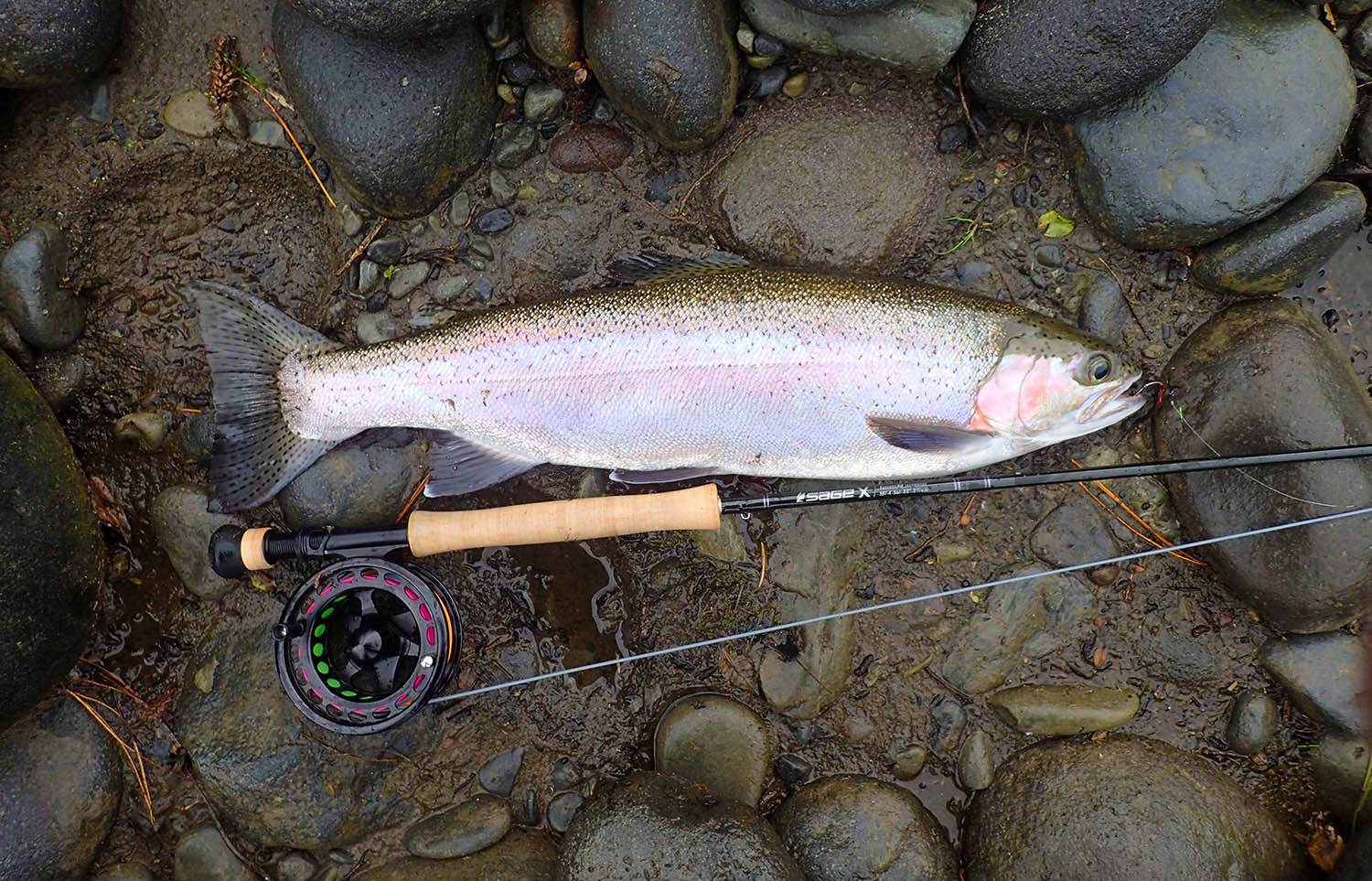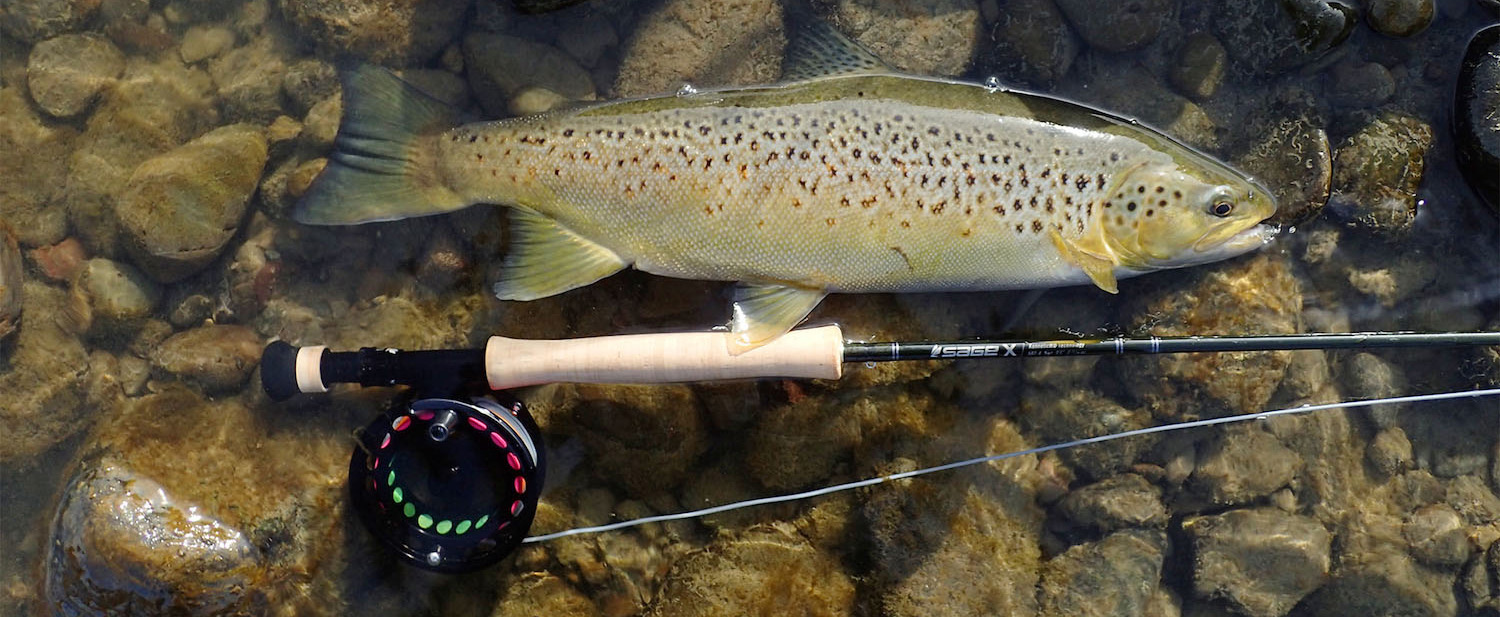There are many good reasons for buying a 9.5 ft 5 wt rod, including extra distance on large rivers and lakes, better line control when nymphing, and easier handling of long leaders, especially with multiple flies. But the reason I wanted one was for my new passion - single hand Spey.
I far prefer single hand rods to light double hand rods for casting the 150 to 210 grain heads suited to small to medium sized rivers; for the following reasons:
1. I can cast heavier tips and bigger streamers with the shorter heads that 9 -9.5 ft rods like, which is of course assisted by a haul and an extended single hand sweep.
2. Short heads cross fewer current lanes, and combined with high sticking a thin mono running line I can achieved drifts not possible with longer heads or regular fly lines.
3. With my left hand hauling and controlling the shoot, and my right hand wielding the rod, I am more accurate, I can cast further, and also feel better integrated with the system.
4. I have more control when stripping streamers.
5. I can handle much bigger fish with a single handed 5 wt than I could with a one or two weight double hander, which is important in New Zealand.
Two years of experiments aimed at optimising single-hand Skagit-systems proved that a 9.5 foot rod handles longer tips than a 9 footer, and is capable of easier roll/Spey casting and greater distance. I chose the Sage X 597 because it comes with a fighting butt, and it was purported to flex more deeply than similar models from other brands, which suggested it would be well suited to Spey casting.
First Impressions
There is a lot already written about the technology used to produce Sage X-series, and the appearance of these rods, so I wont dwell on these here. Suffice it to say that I love the dark and understated appearance of the birch green version, and the fit and finish on my rod is excellent, although not quite up to the standard of some Scott and Loomis rods I own.
Comparing my five 5 weight rods side by side I noticed the X-597 did not appear to be as long as I had anticipated. A tape measure revealed that although the Sage was 9 ft and six inches long, one inch of the total length was fighting butt.
My 9 ft Loomis and Hardy rods were, on the other hand, one or two inches longer than they were supposed to be, so the working portion of these sticks was only three or four inches shorter than the X-597.
The first thing I did after setting up and inspecting my new toy, was to overhead cast it on the front lawn with a 5 wt Airflo Tracker; a half size heavy front loaded floating line. The X-597X had a surprisingly low swing weight for its length, and casts with the 5 wt floating line were smooth and accurate - a function of both the rod action and the profile of the Tracker.
Flexing well into the mid-section, the 597X felt like a typical medium fast action rod, but when I made the final forward delivery the line shot like a rocket, as long as I held back on aggression and let the rod do the work.
It took a while for my mind to reconcile flex with fast action, and for the rod to teach me to relax and to slow down, which was reminiscent of learning to Skagit cast.

A fresh-run Tongariro rainbow taken on my favourite single hand Skagit outfit: a Sage 597x with 180 grain intermediate Skagit Lite head and a #6 S6 Rio Replacement Tip
Spey casting
When the wind and rain of late winter finally let up for a few hours on a weekend I shot down to the wide lower reaches of the Otaki River. I started off with an 11.2 ft 187 grain Scientific Angler Skagit Lite 180 - which had proven to be the ultimate Skagit head for casting level-T sink tips on 9 ft 5 wt single hand rods.
The Skagit Lite series is unique in the world of micro-Skagit in that it has a near delta-profile, with a long gradual front taper, comprising around 66-80% of the total head length, that ends in a relatively thick tip.
This profile places maximum weight in the upper portion of the D-loop, where it is most efficient at loading the rod, while the long front taper delays and smooths turnover, resulting in surprising distance and presentation with short heads.
Using the head version of the Skagit Lite 180 with 35 lb OPST Lazer running line, I cast the following tips: 9 ft T-8, 9 ft of T-11, light 3D MOW tips in S3/S4/S5 and S5/S6/S7 configurations and a 114 grain Airflo T-7 Flo Tip. The fly was a size 6 rabbit streamer with a 4.7mm brass bead and lead underbody.
It took just a minute to get used to the action of the X-597, and once I had, casts of 70 to 80 feet were easily achievable with all of the sink tips; and with a lot less effort than I needed when making 60 foot casts with my 9 ft rods.
It didn’t matter whether I snake rolled, snap-Ted or peri-poked, distance and presentation were exceptional.
I next tried the 12.3 ft 216 grain Skagit Lite 210, and to my amazement, I hardly felt a difference - except that in addition to the previous tips I could also comfortably cast a 130 grain T-10 Flo tip. Even though the X 597 flexes deeply, it has an uncanny ability to absorb additional weight, and then up the anti to unleash appropriate power.
The 216 grains Skagit Lite 210 feels clunky on all my 9 ft 5 wts that match well with the Skagit Lite 180 - 200 grains being the maximum they like to cast.
Impressed by the ability of the X-597 to compensate for additional head weight, I decided to see how it would cope with less, and tried a 150 grain Skagit Lite. The fly was a size 10 pine squirrel zonker streamer with lead underbody and 3.5 mm tungsten bead, and for tips I used a 49 grain Airflo Extra Strong 10 ft clear intermediate Polyleader, and a 61 grain 10 ft #5 Rio Replacement Tip.
As I suspected, the X-597 had no trouble at all with the lighter head. Overhead casting was exceptional, touch and go casts were excellent, and even sustained anchor casts were good. Presentation was of course outstanding, making this a great combination for swinging soft hackles and small streamers in low clear summer conditions, thus expanding the reach the X-597.
Continuing with presentation theme, but with a head of more appropriate weight, I next fished a 15 foot 186 grain Scout 180 with the same Rio Replacement tip and small streamer. Greater total length and gentle 5.5 ft front and 2 ft rear tapers, ending in relatively thick tips, means the Scout has a remarkably thin belly, and also turns over slowly.
This proved to be another magic combination on the X-597, delivering smooth tight loops, casts of 80 feet and more, and incredibly good presentation for a Skagit head. In fact it felt more like a 2D scandi than a Skagit head.
For those only interested in purchasing one Skagit head for the 597X I tried fishing the Skagit Lite 180 with #5 and #6 Rio Replacement tips for situations when smaller flies and finesse were required.
The 65 grain #6 tips proved to be a better match for the power unleashed by this line, and presentation, although not as good as with the Scout 180, was more than acceptable.
The intermediate version of the Skagit Lite 180 with a 10 ft S6 6wt replacement tip turned out to be a deadly combo on the 597X, capable of casting substantial rabbit streamers with 5mm brass beads, and achieving considerable depth in larger rivers.
The intermediate head also sliced through wind, the enemy of lighter floating Skagit heads, and landed with considerably less splash.
Overhead Casting
Finally, in the interests of a more rounded review I tried fishing dry flies and nymphs on the 597X with the Airflo Tracker and a 15 ft leader. Accuracy with a big bushy dry was excellent, but what impressed most was the amazing ability of the 597X to cast a #6 foam and deer hair cicada with two weighted nymphs - #14 Tungsten bead and #16 weighted pheasant tail - on the long leader. Mending was also noticeably easier than with a 9 foot rod.
My 597X would be a fantastic rod for nymphing larger rivers, such as the Tongariro, in summer - if it were not permanently strung up with a Skagit head.
Conclusion
The X-597 is one of those rods that seem to have a life of its own, appearing to respond with a lot more energy than the angler puts into the cast - as long as he is not overly aggressive, which is counterproductive when Spey casting anyway.
The combination of good flex through the mid section, fast recovery and an extra few inches makes the Sage X-597 an exceptional single-hand Spey-casting tool, allowing me to achieve a third more distance with much less effort than with my regular ‘9 ft’ 5 wt rods.
Easily handling a wider head weight window than other rods I have fished, means I can fish lighter heads and sink tips when presentation is important, and heavier heads and tips when I need to get down deep. It is also a great tool for fishing weighted nymphs on large New Zealand rivers, making the X-597 one versatile stick.
See other reviews :
